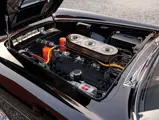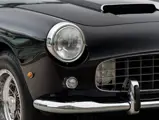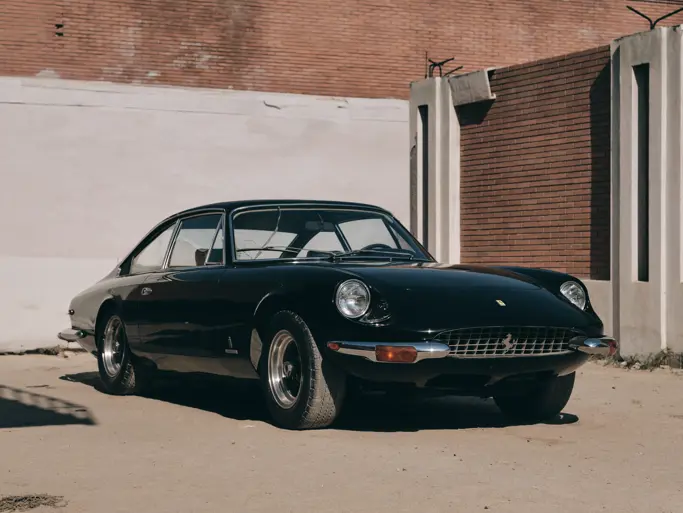Monterey 2019
1961 Ferrari 250 GT Cabriolet Series II by Pininfarina
{{lr.item.text}}
$1,517,500 USD | Sold
 | Monterey, California
| Monterey, California
{{internetCurrentBid}}
{{internetTimeLeft}}

- The 150th of 200 examples built
- Retains its original engine, transmission, and differential
- Recent cosmetic restoration, refinished in Nero
- An ideal concours entrant or tour participant
By the late 1950s Ferrari’s success on the racetrack cemented their status across Europe and North America. Its road cars were gaining greater popularity as a result. At first, its limited-production and coachbuilt road cars were a means to an end for its racing efforts, bringing in much-needed funds to ensure Ferrari remained competitive on the track. However, as time marched on, the road cars would become an equally important part of the marque’s lineup. In particular, the 250 series proved that Ferrari could have its cake and eat it, too.
Underpinning not only Le Mans winners but its grand touring cars, the 3.0-liter Colombo V-12 and 250 GT chassis could seemingly do it all. From the lovely Lusso and the sporty California Spider, to the Tour de France and—of course—the 250 GT cabriolet, the basic construction formula was nothing short of perfect. Clothed in quintessentially Italian bodywork, these cars looked as beautiful as they drove.
Of these models, the 250 GT cabriolet was the true gentleman’s Ferrari. More at home cruising the coastline of the South of France than rocketing down the Mulsanne Straight, the cabriolet was built for those individuals who respected Ferrari’s racing pedigree yet wanted something much more civilized, comfortable, and practical than its racing counterparts. As such, personalization played a key role; in many cases, the owners’ wishes were Ferrari’s command.
Upon its debut in 1959 at the Paris Motor Show, the second-series 250 GT cabriolet offered a variety of subtle changes over the first-series models. These included open headlamps with a slightly more rounded nose and elongated taillamp lenses. Slightly more space in the interior and trunk also made long journeys more comfortable. Ferrari also fitted the car with the updated, outside-plug version of the Colombo V-12, designated Tipo 128F. Over the course of three years of production, just 200 second-series cabriolets were produced. This was an exquisite machine for exquisite customers with exquisite taste.
Completed by the factory in November 1961 and delivered new to Luigi Chinetti Motors in New York, chassis 3009 GT was the 150th of the 200 Series II examples constructed. Sporting a unique color scheme of Verde Italver (6012) over Natural Franzi leather (NR1), the car was sold new to its first owner, Angelo Roma of New York, in January 1962. A native Italian, Roma was privileged enough to own a handful of other Ferraris, including a 250 GT SWB berlinetta, 250 GT LWB alloy berlinetta “Tour de France,” and another Series II cabriolet.
It is believed 3009 GT remained in the United States in Roma’s ownership, rather than traveling back across the Atlantic to Italy. By the mid-1960s, it had moved to the West Coast and was owned by Arthur L. True of Spokane, Washington. True was certainly no stranger to Ferraris and sports cars of the era. An avid car collector and amateur race driver who competed in Europe and North America, his collection included a 250 Testa Rossa (0704 TR), several 300 SLs, a Porsche 904, and numerous other road and track cars. True bequeathed most of his collection to the Henry Ford Museum in 1967. However, chassis number 3009 GT remained in Washington and is instead noted as being owned in the 1980s by Willard Quinn III, also of Spokane. By 1989 the car had returned across the Atlantic and was purchased by Erich Traber of Switzerland. It would remain there for a decade with Traber, who painted the car gunmetal grey and retrimmed the interior in red leather.
In November 2004 the cabriolet was sold to a collector in Japan, where it remained for several years, then returned to the United States in 2010. Upon its arrival in California, the car was sent to the marque specialists at Fast Cars Ltd. in Redondo Beach for a complete restoration. More recently, the car has received further cosmetic work, including being repainted in striking Nero, along with an engine rebuild. Furthermore, it is noted that 3009 GT retains its original engine, transmission, and rear differential and is currently undergoing Ferrari Classiche certification, which is expected to be completed shortly after the sale at the seller’s expense. Additionally, the Ferrari is accompanied by a full set of reproduction tools along with a reprinted 250 GT owner’s manual.
Sixty years after the car’s unveiling at the Paris Motor Show, the 250 GT cabriolet is regarded by many as the quintessential gentleman’s open-top Ferrari, one that is as stately as it is practical and fun to drive. Thanks to its cosmetic and mechanical work, 3009 GT would be an excellent car to drive, enjoy, and show at concours and Ferrari club events.































